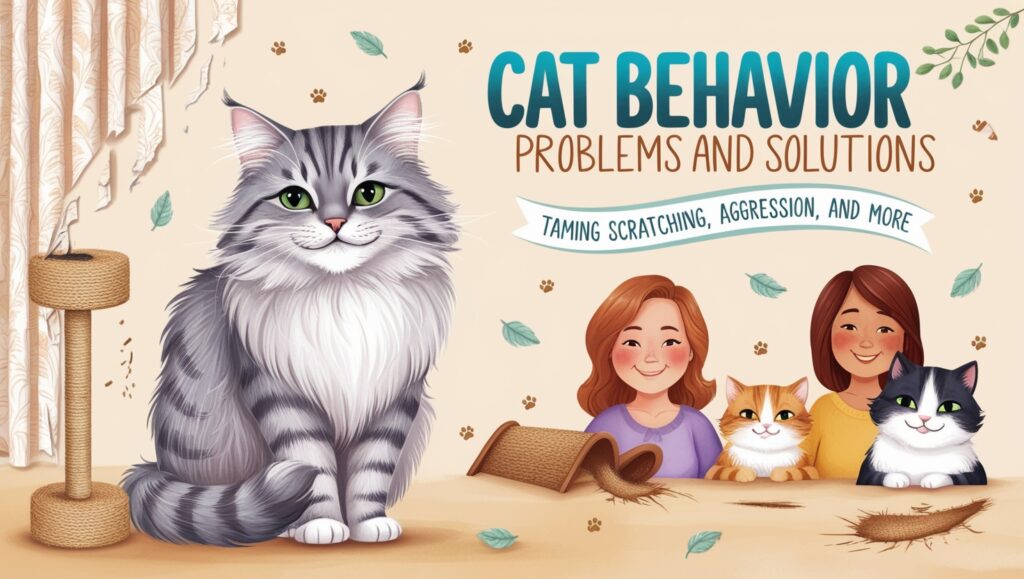As cat owners, we adore our feline friends for their independent nature and quirky personalities. However, sometimes their behaviors can be challenging. From scratching furniture to showing aggression, these issues can strain the bond between cats and their humans. In this comprehensive guide, we’ll explore common cat behavior problems and provide effective, humane solutions to help create harmony in your home.
Understanding Cat Behavior
Before diving into specific problems, it’s crucial to understand that most “problematic” behaviors are actually natural for cats. Our goal isn’t to eliminate these behaviors entirely but to redirect them in ways that are acceptable in our homes.
Common Cat Behavior Problems and Solutions
1. Scratching Furniture
Scratching is a natural and necessary behavior for cats. It helps them stretch, mark their territory, and maintain their claws.
Solutions:
- Provide appropriate scratching posts with different textures (sisal, cardboard, carpet)
- Place scratching posts near furniture they like to scratch
- Use positive reinforcement when they use the scratching post
- Apply double-sided tape or aluminum foil on furniture as a deterrent
- Consider nail caps as a temporary solution
2. Aggression Towards Humans or Other Pets
Aggression can stem from fear, territorial issues, or play that gets out of hand.
Solutions:
- Identify and remove triggers when possible
- Use positive reinforcement to reward calm behavior
- Provide plenty of vertical space and hiding spots to reduce stress
- For inter-cat aggression, ensure each cat has their own resources (litter boxes, food bowls, etc.)
- Consult with a veterinarian to rule out medical causes
3. Inappropriate Elimination
When cats stop using their litter box, it’s often due to medical issues or litter box aversion.
Solutions:
- Rule out medical problems with a vet check-up
- Keep litter boxes clean (scoop daily, deep clean weekly)
- Provide one litter box per cat, plus one extra
- Try different types of litter to find your cat’s preference
- Place litter boxes in quiet, accessible locations
4. Excessive Vocalization
While some breeds are naturally talkative, excessive meowing can be a sign of distress or an attempt to get attention.
Solutions:
- Rule out medical issues, especially in older cats
- Establish a routine for feeding and playtime
- Ignore attention-seeking meows and reward quiet behavior
- Provide environmental enrichment to prevent boredom
5. Nighttime Activity
Cats are naturally more active at dawn and dusk, which can disrupt our sleep schedules.
Solutions:
- Engage in interactive play before bedtime to tire them out
- Provide food puzzles or slow-release feeders for nighttime entertainment
- Keep cats out of the bedroom if necessary
- Ignore nighttime behavior to avoid reinforcing it
The Power of Positive Reinforcement
Throughout this guide, you’ve noticed a common theme: positive reinforcement. This technique is incredibly effective for modifying cat behavior. Here’s how to use it:
- Identify the desired behavior
- Choose a reward your cat loves (treats, praise, playtime)
- Immediately reward the cat when they exhibit the desired behavior
- Be consistent in your rewards
Remember, punishment is not effective for cats and can damage your relationship. Always focus on rewarding good behavior rather than punishing bad behavior.
When to Seek Professional Help
If behavior problems persist despite your best efforts, it’s time to consult professionals:
- Veterinarian: To rule out medical causes for behavior changes
- Certified Animal Behaviorist: For personalized behavior modification plans
- Certified Cat Behavior Consultant: For specific cat behavior expertise
Conclusion
Dealing with cat behavior problems requires patience, understanding, and consistency. By providing appropriate outlets for natural behaviors, using positive reinforcement, and creating a stress-free environment, you can solve many common issues. Remember, every cat is unique, so what works for one may not work for another. Stay patient and keep trying different solutions until you find what works best for you and your feline friend.



